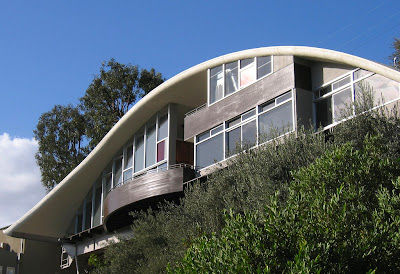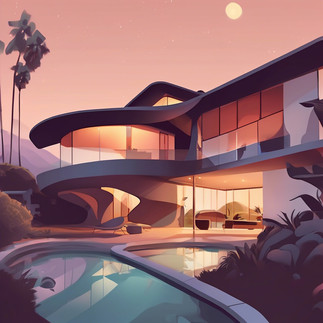The Legacy of John Lautner: A Mastermind of Organic Architecture
- CHA

- Mar 17
- 4 min read

When it comes to bold, visionary architecture, few names stand out as strongly as John Lautner. Throughout the 20th century, Lautner’s designs pushed the boundaries of conventional architecture, leaving a lasting mark on the profession. As an architect who was deeply inspired by nature, he seamlessly blended organic elements with modernist principles to create structures that were not only visually striking and expertly engineered but also harmonious with their surroundings.
Early Life and Career of John Lautner Architect
John Lautner was born in Michigan in 1911, and from an early age, he showed an affinity for design and construction. His journey into architecture began when he joined the prestigious Frank Lloyd Wright’s Taliesin Fellowship, where he had the opportunity to work alongside one of the most influential architects of all time. This exposure to Wright’s innovative philosophies profoundly shaped Lautner’s career.
Lautner's Architectural Philosophy
Lautner’s approach to design was deeply rooted in the idea of “organic architecture.” Like his mentor Wright, Lautner believed that buildings should be a natural extension of their environment. His structures were never just objects sitting on a plot of land; they were part of the landscape, working with it rather than imposing upon it. Lautner was known for his creative use of materials, clean lines, and dramatic forms that brought the outdoors inside, creating living spaces that felt open and connected to the world beyond.
One of Lautner’s key innovations was the idea of the "open plan." His spaces emphasised fluidity and openness, breaking down walls and barriers to allow for a more fluid and organic experience. Through the clever use of glass, steel, and concrete, Lautner designed buildings that were not confined by traditional architectural limitations. The result? A series of dynamic, visionary homes that blurred the lines between indoor and outdoor living.
Iconic Works
While Lautner’s career spanned several decades, it’s his later works that have truly defined his legacy. Some of his most notable designs include:
The Chemosphere (1960)
Perhaps Lautner’s most iconic structure, the Chemosphere is a futuristic home that appears to float above the Los Angeles landscape. Sitting atop a 60-foot pole, this octagonal, suspended house challenges traditional notions of what a home should look like, offering panoramic views of the surrounding hills and city below.

The Elrod House (1968)
Another standout work, the Elrod House in Palm Springs is a perfect example of Lautner’s ability to blend architecture with nature. The home’s circular design and expansive glass walls create a seamless connection to the desert landscape, while the bold roofline gives it a striking, sculptural presence. It’s no wonder the Elrod House became famous as the setting for a James Bond film.

The Sheats Residence (1963)
The Sheats Residence, perched high in the hills above Los Angeles, is one of Lautner’s most celebrated designs. This expansive home features dramatic concrete and glass elements, with large windows framing stunning views of the city below. The home is an excellent example of Lautner’s ability to merge architecture with the natural surroundings, and the seamless integration of indoor and outdoor spaces remains a hallmark of his work.

The Garcia House (1962)
Located in the Hollywood Hills, the Garcia House is an exceptional display of Lautner’s signature style. The house’s unique, triangular shape, cantilevered design, and extensive use of glass allow it to blend harmoniously into its mountainous surroundings. The Garcia House stands as a striking example of Lautner’s vision of creating architecture that works in tandem with nature, rather than against it.

The Legacy of John Lautner
Despite his ground breaking contributions, Lautner’s work was often overlooked during his lifetime. It wasn’t until later that the full extent of his impact on architecture was recognised. His homes and buildings have since become prized examples of innovative, forward-thinking design, admired for their creativity, functionality, and timeless beauty.
Today, Lautner’s work continues to inspire architects and designers all over the world. His ability to marry the natural world with cutting-edge modernist design has influenced countless projects and helped pave the way for a new generation of architects focused on sustainability, innovation, and the seamless integration of space with its environment.
Lautner’s Influence and Relevance Today
The principles that guided John Lautner’s work are incredibly relevant in today’s architectural landscape. His commitment to blending architecture with the natural environment aligns perfectly with current trends emphasising sustainability, eco-friendly design, and biophilic architecture. As we continue to face climate challenges and a growing demand for sustainable living, Lautner’s designs stand as a reminder of the potential for architecture to harmonise with nature rather than dominate it.
His approach to open, flexible floor plans also echoes the modern desire for multi-functional spaces that adapt to the needs of today’s dynamic lifestyles. With the rise of remote work, for example, architects are increasingly designing homes that cater to diverse activities—living, working, relaxing—all within the same fluid, connected space. Lautner’s ability to create homes that foster a deep connection with their surroundings resonates with this modern demand for holistic living environments.
Furthermore, Lautner’s innovative use of materials and his willingness to experiment with new forms are qualities that continue to inspire today’s architects to push boundaries and explore cutting-edge techniques. The rise of new technologies, such as 3D printing and sustainable materials, invites architects to revisit Lautner’s daring spirit of experimentation. His works remind us that the true essence of innovation lies not in conformity, but in boldness, creativity, and a willingness to challenge norms.
Conclusion
John Lautner’s legacy is a testament to the power of architecture to transcend the mundane and reach for something far greater. His work embodies the ideal that architecture is not just about creating buildings; it’s about creating experiences that connect people to their environment in meaningful ways. As an inspiration, Lautner continues to remind architects and designers of the transformative potential of their craft.
As you move forward in your own architectural pursuits, let Lautner’s ground breaking designs inspire you to push your own creative limits, to embrace the natural world as a co-creator, and to design spaces that are not just structures, but living, breathing works of art that transcend time and place.











